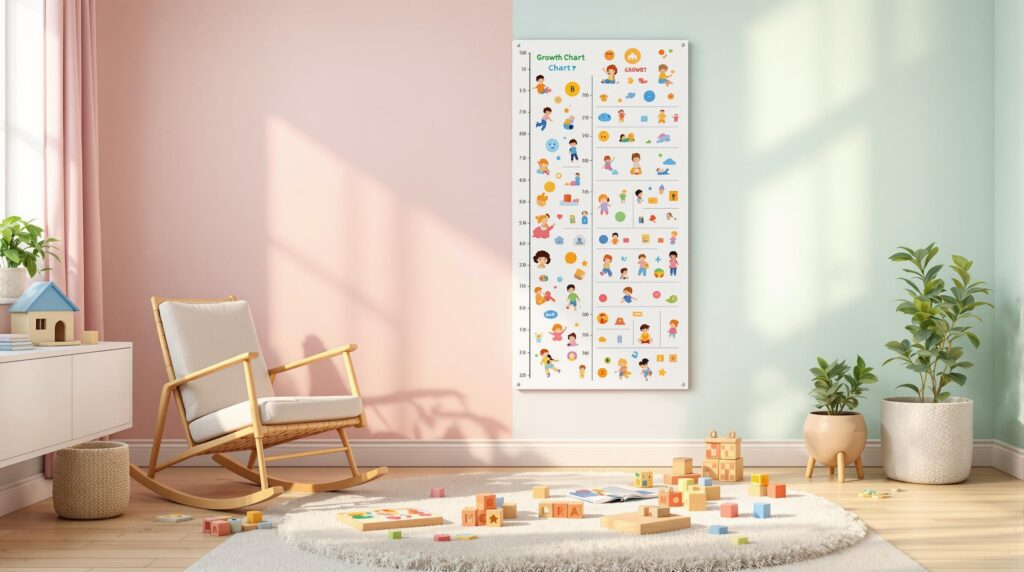Table of Contents
ToggleTracking your baby’s growth and development is an essential part of parenting. It helps you understand your child’s progress and identify any potential concerns early on. As a parent, you play a crucial role in monitoring and supporting your little one’s journey. Let’s dive into the various aspects of accurately tracking your baby’s growth and development.
Understanding Developmental Milestones: The Foundation of Tracking
Developmental milestones are the building blocks of your baby’s growth. They’re categorized into five main domains: gross motor, fine motor, language, cognitive, and social-emotional and behavioral. By keeping an eye on these milestones, you can spot any delays and take action early if needed.
Let’s break down some key milestones you should watch for:
Gross Motor Skills
These are the big movements your baby makes with their whole body. By 6 months, most babies can roll over. Around 9 months, they’re often standing without support. And by 18 months, many little ones are taking their first independent steps. Understanding gross motor skills helps you track your baby’s physical development accurately.
Fine Motor Skills
Fine motor skills involve smaller, more precise movements. Look for the pincer grasp (using thumb and forefinger to pick up small objects) around 9 months. By 18 months, many toddlers are using utensils to eat. And by 4 years, most children can cut with scissors.
Language Development
Your baby’s language skills will blossom over time. Around 6 months, you might hear consonants in their babbling. By 9 months, many babies say “mama” or “baba.” And by 2 years, most toddlers are forming 2-4 word sentences.
Cognitive Development
Cognitive skills involve thinking and problem-solving. Object permanence (understanding that objects exist even when out of sight) typically develops between 5-8 months. Early language development, which is closely tied to cognitive growth, really takes off between 18-24 months.
Social-Emotional and Behavioral Development
This domain covers how your child interacts with others and manages their emotions. Stranger anxiety often appears around 6 months. By 18 months, many toddlers engage in pretend play. And by 3 years, most children are learning to take turns.
Remember, every child is unique and may reach these milestones at slightly different times. The key is to observe overall progress and discuss any concerns with your pediatrician.

Age-Specific Developmental Expectations: What to Look For
As your baby grows, you’ll notice different skills emerging at various stages. Here’s a breakdown of what to expect:
Infants (0-12 months)
During the first year, your baby will make rapid progress. You’ll see them rolling over, sitting without support, and eventually crawling. Language development starts with cooing and babbling and progresses to simple words. Understanding monthly milestones can help you track your baby’s progress accurately.
Toddlers (1-3 years)
This is an exciting time of exploration and independence. Your toddler will likely start walking alone, engage in pretend play, use utensils, and form short sentences. They’re learning about their world and testing boundaries.
Preschoolers (3-5 years)
Preschoolers are becoming more self-sufficient. They’re often able to dress and undress themselves, take turns with others, and understand basic grammar and colors. Their imaginations are in full swing, and they’re developing more complex social skills.
Here are some specific milestones to watch for:
- By 6 months: Your baby may show stranger anxiety, roll over, and start saying consonants while babbling.
- By 9 months: Look for separation anxiety, standing on hands and feet, and understanding the word “no.”
- By 18 months: Many toddlers are walking alone, eating with utensils, and saying several individual words.
The Role of Parents in Tracking Development
As a parent, you’re the expert on your child. Your observations and interactions play a crucial role in monitoring and supporting your little one’s development. Here’s how you can make a difference:
Engage in Developmental Activities
Participate in activities that promote learning and growth. Read to your child, play interactive games, and provide opportunities for both physical and mental stimulation. The role of play in development is significant, so make sure to incorporate plenty of fun, educational activities into your daily routine.
Monitor Screen Time and Online Safety
In today’s digital age, it’s important to be mindful of your child’s screen time and online activities. Nearly 75% of kids have faced online threats, highlighting the need for parental involvement in ensuring online safety. Set clear guidelines for screen use and maintain open communication about online experiences.
Observe and Document
Keep a record of your child’s developmental milestones. This can be as simple as jotting down notes in a journal or using a dedicated app. Your observations will be invaluable during pediatric check-ups and can help identify any potential concerns early on.
Creating a Supportive Environment for Growth and Development
Your child’s environment plays a significant role in their development. Here’s how you can create a space that nurtures growth:
Organize Your Space
Set up your home in a way that encourages exploration and learning. Create safe spaces for play, provide age-appropriate toys, and ensure that learning materials are easily accessible.
Communicate Clearly
Use simple, clear language when talking to your child. This helps them understand and process information more effectively. As they grow, gradually introduce more complex vocabulary and concepts.
Establish Routines
Consistent routines provide a sense of security and help children understand what to expect. This can include regular meal times, a bedtime routine, and scheduled playtime.
Regular Monitoring and Addressing Developmental Delays
Keeping a close eye on your child’s progress is crucial for identifying any potential delays early. Here’s what you need to know:
Understand Typical Milestones
Familiarize yourself with the typical developmental milestones for your child’s age. This knowledge will help you recognize if your child is falling behind in any areas. For example, if your 6-month-old isn’t rolling over, it might indicate a delay in gross motor skills.
Regular Check-ups
Attend all scheduled pediatric appointments. These check-ups are crucial for tracking your child’s growth and development. Your healthcare provider will conduct developmental screenings and can address any concerns you might have.
Early Intervention
If you or your healthcare provider identify a potential delay, don’t panic. Early intervention can make a significant difference. Many resources and therapies are available to support children with developmental delays and help them catch up.
The Role of Healthcare Providers in Tracking Development
Your pediatrician and other healthcare providers are valuable partners in tracking your child’s development. Here’s how they contribute:
Developmental Screenings
Healthcare providers conduct regular developmental screenings during check-ups. These assessments help identify any potential issues early on. Be sure to share your observations and concerns during these visits.
Guidance and Resources
Your healthcare provider can offer practical advice and resources to support your child’s development. They can recommend activities, exercises, or interventions tailored to your child’s specific needs.
Referrals
If necessary, your pediatrician can refer you to specialists for further evaluation or intervention. This might include speech therapists, occupational therapists, or developmental specialists.
Tools and Resources for Accurate Tracking
Several tools and resources can help you track your child’s development accurately:
Development Tracking Apps
Many smartphone apps allow you to log milestones, track growth, and even compare your child’s progress to typical developmental timelines. Look for apps recommended by pediatricians or reputable parenting organizations.
Online Resources
Websites like the Centers for Disease Control and Prevention (CDC) offer comprehensive guides to child development. These resources often include printable checklists and detailed information about milestones.
Baby Books and Journals
Traditional baby books or developmental journals can be a great way to track your child’s progress. They often include spaces to record milestones, growth measurements, and special memories.
Understanding Cognitive Development: Piaget’s Stages
Jean Piaget’s theory of cognitive development provides a framework for understanding how children think and reason at different ages. Here’s a brief overview of the four stages:
Sensorimotor Stage (Birth to 2 Years)
During this stage, babies learn about the world through their senses and motor actions. They develop object permanence and begin to use mental representations.
Preoperational Stage (2 to 7 Years)
Children in this stage develop symbolic thinking, allowing them to use words and images to represent objects. However, their thinking is still very egocentric.
Concrete Operational Stage (7 to 11 Years)
At this stage, children can think logically about concrete situations. They develop the ability to classify and order objects and understand conservation of number, mass, and volume.
Formal Operational Stage (12 Years and Older)
This final stage involves the ability to think abstractly and reason hypothetically. Adolescents can engage in more complex problem-solving and consider multiple perspectives.
Understanding these stages can help you interpret your baby’s growth spurts and cognitive leaps more accurately.
Cultural and Social Considerations in Development Tracking
It’s important to remember that development can be influenced by cultural and social factors. Here’s what to keep in mind:
Cultural Variations
Different cultures may prioritize certain skills or milestones differently. For example, some cultures may emphasize early language development, while others focus more on physical skills. Be aware of these differences when tracking your child’s progress.
Social Environment
A child’s social environment, including family structure, socioeconomic status, and community resources, can impact development. Consider these factors when evaluating your child’s progress and accessing support services.
Inclusive Approach
When using developmental resources or interacting with healthcare providers, seek out culturally sensitive and inclusive information. This ensures that your child’s unique background and experiences are taken into account.
Remember, tracking your baby’s growth accurately is an ongoing process. By staying informed, observant, and proactive, you can support your child’s development effectively and address any concerns promptly. Celebrate each milestone and remember that every child develops at their own pace. Your love, support, and attention are the most crucial factors in your child’s growth and development.
Sources:
Developmental Milestones – PubMed
Piaget Cognitive Stages of Development – WebMD
Consumer Education Websites: A Guide to Creating a Family-Friendly Experience












